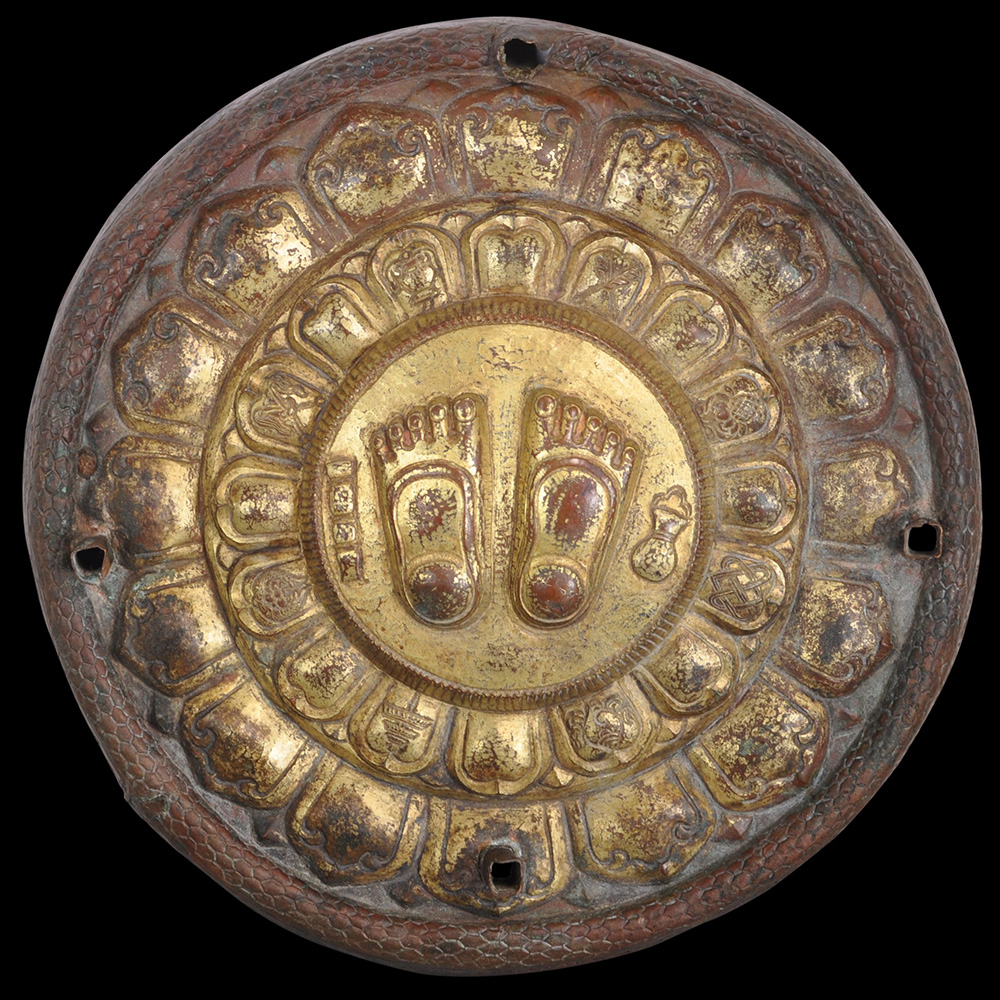|
2. Rare, Nepalese Inscribed & Gilded Copper Buddha’s Footprints Buddhapada Portable Mandala Plaque Nepal 17th-18th century copper diameter: approximately 27cm, weight: 669g |

This exceptionally rare model of the Buddha’s footprints arranged in a mandala has been repoussed in high relief from a thick copper sheet that has then been gilded. The outer rim is pieced with four holes (three with remaining support plugs) from which the supports for a canopy was raised over the footprints. The footprints are accompanied by representations of a water vessel and what might be a walking staff. They are surrounded by two rows of lotus petals. The inner row is alternatively plain and repoussed with Buddhistic motifs such as a conch shell and an endless knot. The outer row are unembellished. The outer edge of the plaque is marked by the rounded, scaly body of a naga. A single line of Newar script runs around approximately a quarter if the outer edge of the plaque. Probably this names the commissioner/donor of the plaque. Such portable mandalas were used in Newar Buddhism – the Newars being the dominant ethnic group in the Kathmandu Valley. The historical Buddha was revered at first by symbols rather than by figurative images, most particularly because the Buddha himself preached about the danger of attachment to icons and idolatrous representation. Thus, early imagery for the Buddha included an empty throne, the Bodhi tree, a riderless horse, and the Buddha’s footprints, whereby the Buddha was inferred by his absence. Eventually, representations of the Buddha’s footprints or Buddhapada came to suggest the period just after his enlightenment or Nirvana when the only representation of the Buddha to remain on the Earth were his footprints. Footprints used in this manner have their corollary in Hinduism – in fact, it is likely that the worship of footprints was copied from Buddhism to Hinduism rather than the other way round. The pada-puja or the worship of the foot or feet in India is most associated with Vishnu and also Krishna. Perhaps abound the fifth century AD, followers of Vishnu adopted representations of Vishnu’s feet (Vishnupada) as part of their rituals, most particularly in Rajasthan. The plaque here has a wonderful patina. The gilding has softened with time and worn here and there leaving behind the underlying copper. REFERENCES: Bazin, N., et al, Nepal: Art de le Vallee de Katmandou, Musee National des Arts Asiatiques – Guimet, 2021. Henss, M., Buddhist Ritual Art of Tibet: A Handbook on Ceremonial Objects and Ritual Furnishings in the Tibetan Temple, Arnoldsche, 2020. Jain-Neubauer, J., Feet & Footwear in Indian Culture, Bata Shoe Museum/Mapin, 2000. Itemcode: 7325 Detail: Side Detail: Rear |